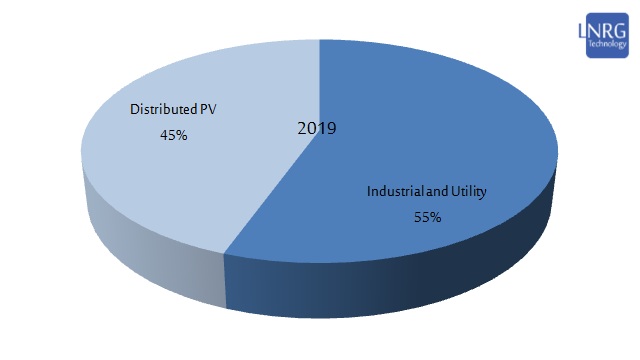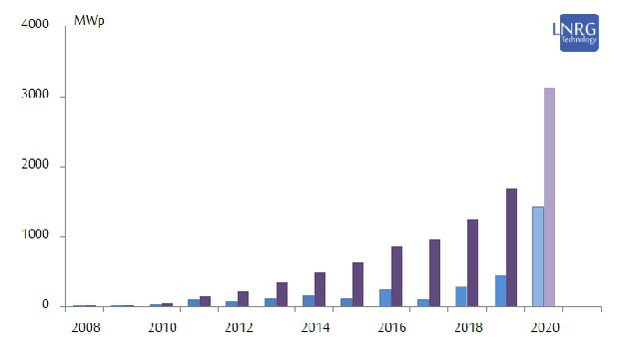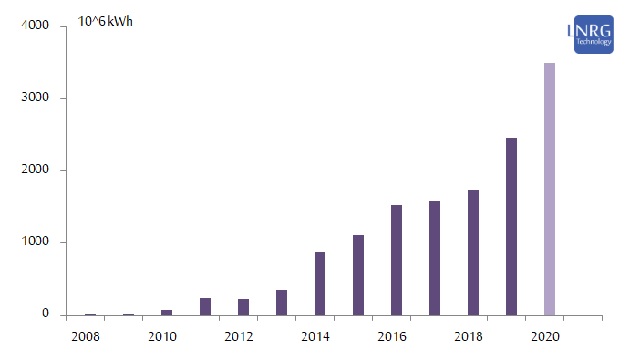
Solar photovoltaic (PV) facilities are continuing to form a dominant share of new capacity additions in the electricity generation segment worldwide and specifically in Israel. The total capacity of grid-connected PV facilities in Israel was at 1,690 MWp by the end of 2019 and is expected to surpass 3,100 MWp by the end of 2020. The total capacity of PV facilities increased by 36% year-over-year from the end of 2018 to the end of 2019 and is expected to grow over 80% in 2020 - continuing to rise from previous 29% annual growth rate in 2018. In terms of electric generation, solar PV facilities produced 2,467 million kWh in 2019 – an increase of 41% from 2018. The percentage of solar PV generation out of total electricity generation in the country increased from 2.5% in 2018 to 3.4% in 2019 and is expected to reach over 5.0% in 2020.
Solar photovoltaic (PV) facilities are continuing to form a dominant share of new capacity additions in the electricity generation segment worldwide and specifically in Israel. The global rate of PV deployment has grown exponentially for many years, due to a strong demand for a modular, cheap, reliable and environmentally clean technology for electricity production. PV facilities are utilized for both off-grid energy generation in remote areas, but mainly for grid-connected applications. In Israel, 447 MWp of PV capacity were added in 2019, forming 48% of total added electric capacity, surpassing the share of new natural gas generation and pump accumulation. Moreover, complementary solar technologies have also been introduced into the market over the past several years, including distributed energy harvesting hardware (DC maximizers and micro-inverters), facility planning software solutions, real-time smart monitoring and more. Those complementary solutions assist in integrating more solar PV facilities into the grid and reducing construction and operation costs. While distributed electricity storage solutions have already appeared on the market, they are still a marginal phenomenon. However, further evolution of electricity storage technology would also drive higher levels of PV integration.
Grid-connected solar PV facilities were introduced into Israel in summer 2008, with the first government-subsidized feed-in tariff program for small commercial and residential facilities. Since then, solar PV installations have been ongoing across the country, producing a constantly growing capacity of grid-connected facilities. In 2009, governmental decision #4450 determined a target of 5% renewable electricity production by the year 2014 and 10% renewable electricity production by the year 2020, largely relying on integration of solar energy. Though the 2014 target was missed, two important decisions complemented the previous solar PV deployment plans: one diverting much planned capacity from solar thermal and other renewable technologies to solar PV and another decision (accepted towards the 2015 Paris Climate Summit) setting the targets for renewable electricity production in Israel at 17% by 2030. The most recent revision of the 2030 target by the Ministry of Energy has set a new target at 30% renewables - mostly to be achieved via mass adoption of solar energy and complementary storage.

Figure 1. Structure of Solar PV segment in Israel on December 2019 - share of distributed (residential & commercial) vs solar fields (industrial & utility scale).
The distribution of solar PV facility sizes in Israel very much resembles EU and US markets. The proportion of distributed PV in Israel, including residential and commercial roofs (up to 1 MWp DC, or more specifically up to 630KVA), was 45% as of December 2019; whereas the rest are PV fields including industrial (1-10 MWp, recently expanded up to 16 MWp by definition) and utility-scale (more than 10 MWp and more recently above 16 MWp by definition). The ration of distributed vs industrial+utility remained unchanged from December 2018. In comparison, the proportion of distributed PV in Germany in 2018 was reported to be 52%, while in US it was around 40% at the time. It should be mentioned that Net Metering facilities in Israel were all counted as "distributed" even though some are in fact industrial-scale, due to the fact that Israeli authorities have not made the distinction within the Net Metering program. In 2020, the ratio of distributed solar vs industrial + solar fields in the country is expected to remain about the same, both segments showing an aggressive growth.
Within Israel, one can encounter solar facilities all over the country, with PV technology turning into mainstream means for electricity generation. Since the introduction of the first solar tariff program in 2008, a notable number of various programs and initiatives have evolved. By 2020, six feed-in-tariff programs for small-scale PV facilities have already been implemented, with the seventh FIT program ongoing since August 2018. In addition, one feed-in-tariff quota for medium-sized commercial PV facilities, as well as medium-sized land tenders program and a feed-in-tariff quota for utility-scale PV facilities had been implemented. From 2014 to 2018, Israeli Electricity Authority also introduced Net Metering quota of 400 MWp for residential and commercial PV facilities, issued two tenders for Ashalim solar PV fields and provided licenses to several utility-scale solar PV projects. Finally, in 2018, the Electricity Authority also added an unlimited self-consumption "default" scheme for distributed grid-connected PV facilities and initiated a series of tenders for commercial and utility-scale PV facilities. Over the past two years a series of land PV tenders and three commercial rooftop & water reservoir tenders have successfully been completed.

Figure 2. Solar PV new annual installations (blue) and total PV capacity by the end of each calendar year (purple) in MWp. 2020 figures are an estimate.
The total capacity of grid-connected PV facilities in Israel was at 1690 MWp by the end of 2019 and is expected to surpass 3,100 MWp by the end of 2020. 1,983 MWp solar PV capacity was in contracts with IEC by December 2019. Of those, the largest to become synchronized that year was 120 MWp facility in Tzeelim, Southern Israel. The total capacity of PV facilities increased by 36% year-over-year from the end of 2018 to the end of 2019 and is expected to grow over 80% in 2020 - continuing to rise from previous 29% annual growth rate in 2018. Solar PV segment rose from 4.9% in the end of 2016, 5.4% in the end of 2017 and 6.9% by the end of 2018 to make up 8.9% of grid-connected electric capacity in Israel by the end of 2019. It is expected to reach over 14.0% of total electric capacity by the end of 2020.

Figure 3. Annual electricity production by the solar PV segment in Israel (purple) in millions of kWh. 2020 figures are an estimate.
In terms of electric generation, solar PV facilities produced 2,467 million kWh in 2019 – an increase from 1,584 million kWh in 2017 and 1,747 million kWh in 2018. The percentage of solar PV generation out of total electricity generation in the country increased from 2.3% in 2017 and 2.5% in 2018 to 3.4% in 2019 and is expected to reach over 5.0% by the end of 2020. In 2020, solar PV generation is hence expected to surpass 3,500 million kWh. Solar PV segment is responsible for the majority of renewable electricity generation in Israel, which altogether reached the level of 1,786 million kWh in 2017, 2,038 million kWh in 2018 and finally 3,363 million kWh in 2019.
The extended commercial report can be purchased at LNRG Technology digital store.





